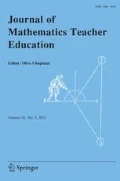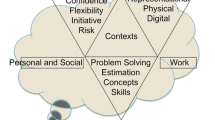Abstract
This article examines the ways in which prospective elementary teachers’ develop an understanding of language use for defining the whole throughout a 9-day rational number unit. Student work samples and classroom conversations are used to illustrate their difficulties and growth with defining the whole and corresponding language use for describing fractional amounts. The results indicate that three mathematical ideas became taken-as-shared by the class. The first was that fractions depend on a group or whole. The second included defining an of what. The third was developing language in terms of what the denominator represents. Difficulties prospective teachers had conceptualizing language included distinguishing among the phrases of a, of one, of the, and of each. Implications for mathematics education courses and future research studies are also discussed.




Similar content being viewed by others
References
Ball, D. L. (1990a). Prospective elementary and secondary teachers’ understanding of division. Journal for Research in Mathematics Education, 21(2), 132–144.
Ball, D. L. (1990b). The mathematical understandings that prospective teachers bring to teacher education. The Elementary School Journal, 90(4), 449–466.
Cobb, P., & Gravemeijer, K. (2008). Experimenting to support and understand learning processes. In A. E. Kelly, R. A. Lesh, & J. Y. Baek (Eds.), Handbook of design research methods in education (pp. 68–95). New York, NY: Routledge.
Cobb, P., Stephan, M., McClain, K., & Gravemeijer, K. (2001). Participating in classroom mathematical practices. The Journal of the Learning Sciences, 10(1&2), 113–163.
Cobb, P., & Yackel, E. (1996). Constructivist, emergent, and sociocultural perspectives in the context of developmental research. Educational Psychology, 31(3/4), 175–190.
Conference Board of the Mathematical Sciences. (2001). The mathematical education of teachers. Providence, RI: American Mathematical Society.
Davis, R. B., & Maher, C. A. (1990). What do we do when we “do mathematics”? In R. B. Davis, C. A. Maher, & N. Noddings (Eds.), Constructivist views on the teaching and learning of mathematics (pp. 65–78). Reston, VA: National Council of Teachers of Mathematics.
Glaser, B. G., & Strauss, A. L. (1967). The discovery of grounded theory: Strategies for qualitative research. New York: Aldine.
Graeber, A. O., Tirosh, D., & Glover, R. (1989). Prospective teachers’ misconceptions in solving verbal problems in multiplication and division. Journal for Research in Mathematics Education, 20(1), 95–102.
Gravemeijer, K. (2002). The role of models, symbols, and tools in instructional design. In K. Gravemeijer, R. Lehrer, B. van Oers, & L. Verschaffel (Eds.), Symbolizing, modeling and tool use in mathematics education (pp. 141–143). The Netherland: Kluwer Academic Publishers.
Gravemeijer, K. (2004). Local instruction theories as means of support for teachers in reform mathematics education. Mathematical Thinking and Learning, 6(2), 105–128.
Kieren, T. E. (1980). The rational number construct: Its elements and mechanisms. Paper presented at the Recent Research on Number Learning.
Lamon, S. J. (1996). The development of unitizing: Its role in children’s partitioning strategies. Journal for Research in Mathematics Education, 27(2), 170–193.
Lamon, S. J. (2005). Teaching fractions and ratios for understanding: Essential content knowledge and instructional strategies for teachers. Mahwah, NJ: Lawrence Erlbaum Associates.
Luo, F., Lo, J.-J., & Leu, Y.-C. (2011). Fundamental fraction knowledge of prospective elementary teachers: A cross-national study in the United States and Taiwan. School Science and Mathematics, 111(4), 164–177.
Mack, N. K. (1990). Learning fractions with understanding: Building on informal knowledge. Journal for Research in Mathematics Education, 21(1), 16–32.
Mack, N. K. (1993). Learning rational numbers with understanding: The case of informal knowledge. In T. P. Carpenter, E. Fennema, & T. A. Romberg (Eds.), Rational numbers: An integration of research (pp. 85–106). Hillsdale, NJ: Lawrence Erlbaum Associates.
Mack, N. K. (1995). Confounding whole-number and fraction concepts when building on informal knowledge. Journal for Research in Mathematics Education, 26(5), 422–441.
Mack, N. K. (2001). Building on informal knowledge through instruction in a complex content domain: Partitioning, units, and understanding multiplication of fractions. Journal for Research in Mathematics Education, 32(3), 267–295.
National Council of Teachers of Mathematics. (2006). Curriculum focal points for prekindergarten through grade 8 mathematics. Reston, VA: NCTM.
Ni, Y., & Zhou, Y.-D. (2005). Teaching and learning fraction and rational numbers: The origins and implications of whole number bias. Educational Psychology, 40(1), 27–52.
Rasmussen, C., & Stephan, M. (2008). A methodology for documenting collective activity. In A. E. Kelly, R. A. Lesh, & J. Y. Baek (Eds.), Handbook of design research in methods in education: Innovations in science, technology, engineering, and mathematics learning and teaching (pp. 195–215). New York and London: Routledge.
Simon, M. A. (1993). Prospective elementary teachers’ knowledge of division. Journal for Research in Mathematics Education, 24(3), 233–254.
Stephan, M., & Rasmussen, C. (2002). Classroom mathematical practices in differential equations. The Journal of Mathematical Behavior, 21(4), 459–490.
Streefland, L. (1991). Fractions in realistic mathematics education: A paradigm of developmental research. The Netherlands: Kluwer Academic Publishers.
Tobias, J. M. (2009). Prospective elementary teachers’ development of rational number understanding through the social perspective and the relationship among social and individual environments. Unpublished Dissertation, University of Central Florida, Orlando, FL.
Toulmin, S. E. (2003). The uses of argument (Updated ed.). New York: Cambridge University Press.
Wheeldon, D. (2008). Developing mathematical practices in a social context: An instructional sequence to support prospective elementary teachers’ learning of fractions. Unpublished Dissertation, University of Central Florida, Orlando, FL.
Author information
Authors and Affiliations
Corresponding author
Rights and permissions
About this article
Cite this article
Tobias, J.M. Prospective elementary teachers’ development of fraction language for defining the whole. J Math Teacher Educ 16, 85–103 (2013). https://doi.org/10.1007/s10857-012-9212-5
Published:
Issue Date:
DOI: https://doi.org/10.1007/s10857-012-9212-5




